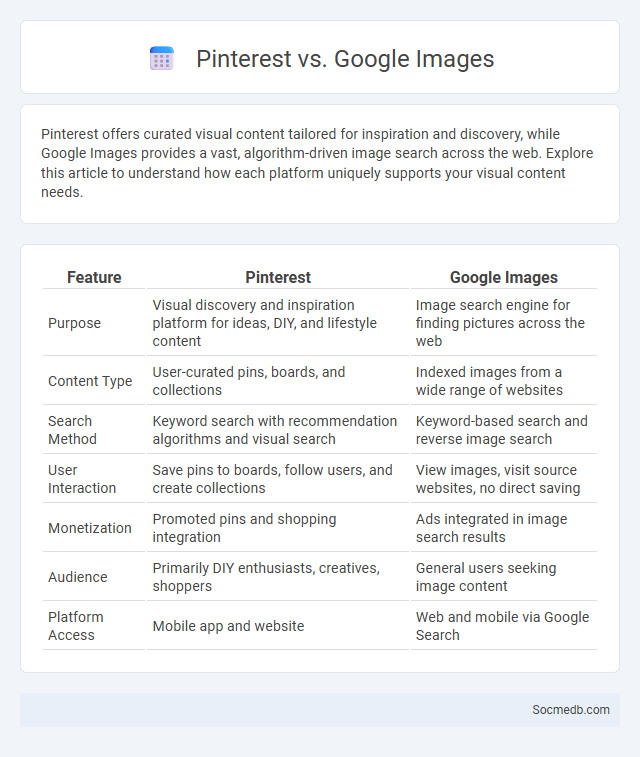
Photo illustration: Pinterest vs Google Images
Pinterest offers curated visual content tailored for inspiration and discovery, while Google Images provides a vast, algorithm-driven image search across the web. Explore this article to understand how each platform uniquely supports your visual content needs.
Table of Comparison
| Feature | Google Images | |
|---|---|---|
| Purpose | Visual discovery and inspiration platform for ideas, DIY, and lifestyle content | Image search engine for finding pictures across the web |
| Content Type | User-curated pins, boards, and collections | Indexed images from a wide range of websites |
| Search Method | Keyword search with recommendation algorithms and visual search | Keyword-based search and reverse image search |
| User Interaction | Save pins to boards, follow users, and create collections | View images, visit source websites, no direct saving |
| Monetization | Promoted pins and shopping integration | Ads integrated in image search results |
| Audience | Primarily DIY enthusiasts, creatives, shoppers | General users seeking image content |
| Platform Access | Mobile app and website | Web and mobile via Google Search |
Overview of Visual Discovery Platforms
Visual discovery platforms revolutionize social media by enabling users to explore and find content through images rather than text. These platforms leverage advanced AI and machine learning algorithms to analyze visual elements, making content discovery more intuitive and personalized. Your engagement on visual discovery tools like Pinterest and Instagram enhances tailored recommendations, boosting content relevance and user experience.
Pinterest: Features and Strengths
Pinterest excels as a visual discovery platform, allowing users to find and save ideas through Pins organized on personalized boards. Its strength lies in advanced image recognition technology and a highly targeted recommendation algorithm that enhances content relevance. You can leverage Pinterest's rich media tools to drive traffic, increase brand visibility, and inspire engagement with visually compelling content tailored to niche interests.
Google Images: Capabilities and Limitations
Google Images offers powerful visual search capabilities, enabling users to find relevant images quickly through keyword input and reverse image search technology. Its extensive database includes millions of images sourced from the web, facilitating content discovery and inspiration for social media marketing and creative projects. However, limitations include potential copyright issues, occasional inaccuracies in image context, and challenges in filtering inappropriate or low-quality content.
The Evolution of Visual Search Technology
Visual search technology has drastically transformed social media platforms by enabling users to find content through images rather than keywords. Advances in machine learning and artificial intelligence have enhanced image recognition accuracy, allowing platforms like Instagram and Pinterest to offer personalized and intuitive search experiences. This evolution drives higher user engagement and creates new opportunities for targeted advertising and e-commerce integration.
Comparison of Search Algorithms
Search algorithms on social media platforms differ significantly in how they prioritize relevance, engagement, and recency. Platforms like Instagram use machine learning to analyze user interaction patterns, while Twitter's algorithm emphasizes real-time trending topics and hashtag popularity. Understanding these differences can help you tailor your content strategy to maximize visibility and engagement.
User Experience: Ease of Use and Accessibility
Social media platforms prioritize user experience by offering intuitive interfaces designed for seamless navigation, ensuring that You can easily access features without confusion. Accessibility improvements include customizable settings such as font size adjustments, contrast modes, and screen reader compatibility to cater to diverse needs. These enhancements collectively promote inclusive participation, making social media a welcoming space for all users.
Image Search Accuracy and Relevance
Social media platforms increasingly rely on advanced image recognition algorithms to enhance image search accuracy and relevance, enabling users to find visual content more efficiently. Machine learning models analyze visual features and contextual metadata to deliver personalized and contextually appropriate search results. Improved accuracy in image tagging and classification reduces irrelevant content, boosting user engagement and satisfaction.
Monetization and E-Commerce Integration
Social media platforms have become powerful tools for monetization through targeted advertising, influencer partnerships, and direct sales features. Your business can leverage integrated e-commerce capabilities such as shoppable posts, in-app checkout, and personalized product recommendations to increase conversions and streamline the customer journey. Optimizing social media strategies with data-driven insights enhances revenue growth and maximizes return on investment.
Privacy and Data Considerations
Social media platforms collect vast amounts of personal data, making privacy a critical concern for users. Your information, including location, browsing habits, and personal preferences, can be tracked, shared, or sold without explicit consent. Implementing strong privacy settings and understanding data usage policies helps protect your digital footprint and maintain control over your online presence.
Which Visual Search Tool is Best for You?
Choosing the best visual search tool for social media depends on the platform's integration, accuracy, and ease of use. Pinterest Lens excels in identifying fashion and home decor items directly from images, making it ideal for lifestyle enthusiasts. Google Lens offers broad versatility with powerful object recognition and real-time search capabilities across various social networks.
 socmedb.com
socmedb.com